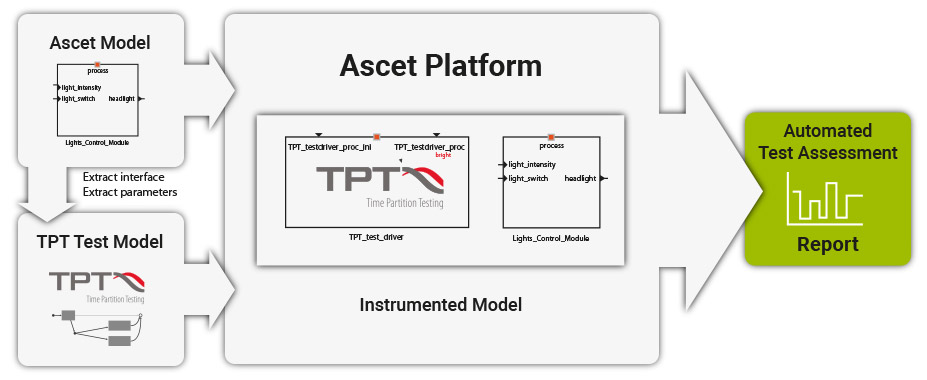TPT. Testing ASCET models has never been easier
TPT is an excellent solution for testing ASCET models. TPT supports fully automated ASCET model testing for both, physical models (Model-in-the-Loop: MIL) and implementation models (Software-in-the-Loop: SIL). Automatic test harness generation for module and integration testing with many features allows very efficient tests, even for large-scale control software. Verification and validation of ASCET models starts here.

Testing ASCET models with TPT. How it works.
TPT makes test setup and test execution of ASCET models very easy. You only have to make a few simple configurations. TPT does all the rest. Fully automated in the background including MiL-SiL back-to-back testing. TPT can control all aspects of ASCET test execution.
Testing ASCET models.
A project in ASCET consists of software modules and tasks with processes. You can test a single module or a complete module group (for integration test) from an ASCET project. You just have to select the appropriate ASCET version, an ASCET project and the tasks you want to test with TPT.
TPT loads the project and experiment necessary for testing, interacts with ASCET before and during test execution and extracts all information needed for seamless automated tests.
Two options. Your choice.
TPT supports two options for testing ASCET models: the “ASCET platform” and the “ASCET@FUSION platform”. These are the differences:
By using the “ASCET platform” in TPT, tests on modules with their tasks are executed directly in ASCET. In this case, ASCET is fully remote controlled by TPT.
The “ASCET@FUSION platform” is more advanced. You can even reschedule processes which requires some more initial setup, but you have more flexibility and tests run much faster.
Interface analysis.
The analysis of the ASCET interfaces is handled automatically. TPT extracts all signals and parameters that can be stimulated or observed during the test execution. The assignment of interface signals as inputs, outputs, and measurements is also determined through an analysis of the model.
As a side node, interface analysis is based directly on the A2L/DCM information from the ASCET project including the default values to be used for the implementation configuration.
Test case design.
TPT has been designed for signal oriented test modeling and it supports many unique techniques for modeling tests.
TPT test case design is very natural and intuitive for ASCET model testing. It is quite easy to create and easy to maintain tests for ASCET with TPT.
Test harness generation.
The test harness and test environment for ASCET testing is automatically generated by TPT. Depending on your choice between the “ASCET platform” and the “ASCET@FUSION platform” the test environment is generated either as a test project in ASCET (consisting of the original model, the TPT test driver, and the associated tasks) or directly as generated and compiled C-code. But don’t worry about the details. It’s all automatic.
Run your ASCET tests.
Test execution is as simple as pushing a button. TPT automatically does all the work for you. TPT starts and controls the entire test execution automatically. Complex tests or test suites can be executed unattended in batch mode.
Analyze your test results.
MIL-SIL back-to-back tests.
Test cases can be executed with physical ASCET models (MiL) or implementation models (SiL). Comparing the behavior between these modes is simple with TPT (for regression/back-to-back testing). Just configure two execution configurations using both simulation modes (MIL and SIL) and enable and configure the back-to-back assessment. TPT will run all tests in the desired modes and compares the results automatically.
Advantages of testing ASCET models with TPT
- Compatible with ASCET DEVELOPER and all 6.x-ASCET versions
- Testing of preconfigured ASCET projects that contain a single or several modules
- Automatic interface analysis of ASCET models
- Automatic testframe (test harness) generation
- Testing of unscaled physical models (MiL) and also of scaled implementation models (SiL)
- Regression tests with unscaled and scaled simulations (MiL-SiL back-to-back testing)
- Linking and tracing of requirements and test cases
- Testing according the safety standard ISO 26262

